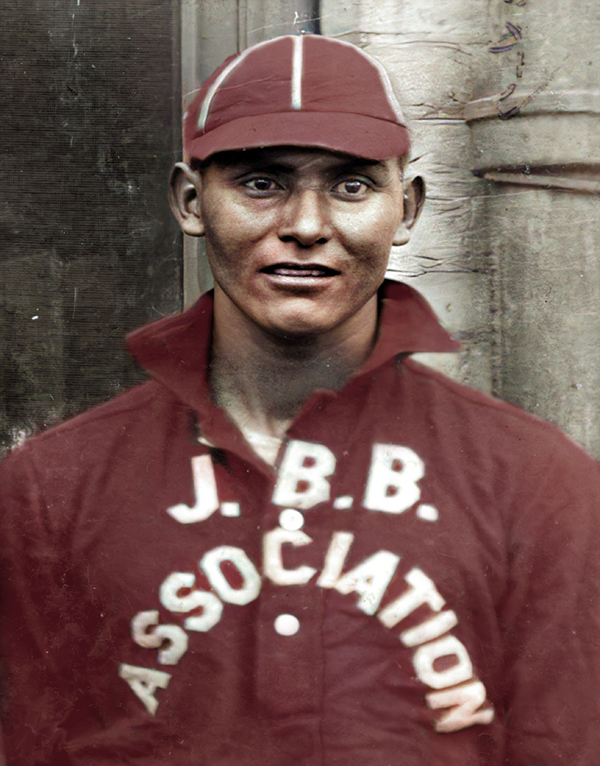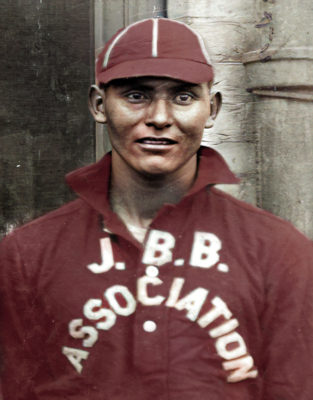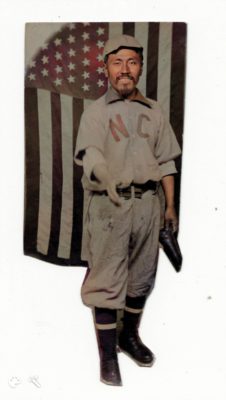Featured Panoramic Photo Above:
1929 National League Champion Chicago Cubs
(Player identifications available upon request)
Baseball History Comes Alive Now Ranked #2 by Feedspot Among All Internet Baseball History Websites and Blogs!
Guest Submissions from Our Readers Always Welcome! Click for details
Subscribe to Baseball History Comes Alive! for automatic updates (sign-up block found in right side-bar)
As a Free Bonus for subscribing, you’ll get instant access to my two Special Reports: Memorable World Series Moments and Gary’s Handy Dandy World Series Reference Guide!
Japanese and Native American Photo Gallery
Click on any image below to see photos in full size and to start Photo Gallery:
Today we offer our readers something a bit different. We’re very happy to feature a second guest post from SABR member Rob Fitts. Rob is a recognized authority on Japanese baseball. An acclaimed author, he has written five books on the subject. I think you’ll find interesting, as I did, his account of how a native American began his career as a member of the traveling Japanese team. He also provides a nice history of native American baseball in the early decades of the 20th century. It’s a bit longer than our usual offerings, but well worth the couple minutes it takes to read it in its entirety. You won’t be disappointed:
How a Native American Star Began his Career as a Japanese
Harry Saisho had a problem. He wanted to transform his Los Angeles-based Japanese Base Ball Association (JBBA) from amateur squad to a professional barnstorming team and he needed a pitcher.
In the first decade of the twentieth century, high-quality Japanese pitchers were rare in the U.S. In November 1908 Saisho and JBBA’s president, Dr. Takejiro Ito, went to Oakland to recruit a pitcher. A long article in the Reno Evening Gazette, probably republished from a Bay Area newspaper, describes their elusive search:
For three years he [Harry Saisho] has been developing a little squad of Nippon athletes until he has one of the fastest fielding teams in the southern part of the state. He has infielders that are above the ordinary, outfielders that are certain and a good catcher—but the pitcher is lacking. That is the weakness in the Japanese ball team that Saisho must overcome. He has brought pitchers from every town along the coast south of Vancouver and they have failed to develop a pitching arm. . . .
Dr. Ito and Captain Saisho are in Oakland looking for a pitcher. . . . When you ask Ito what is the matter with having a Japanese pitcher, he throws up his hands, bites his underlip suggestively and . . . gives an explanation of his native countrymen. “Japanese are not built for pitching. . . . They haven’t a throwing arm. One reason is that the arm is too short, another is that the shoulder is too close set against the body. Our people are the greatest contortionists in the world but they can’t stand the strain of pitching for their shoulders always give out. The players can’t curve the balls either like you Americans. I thought at first it was the height, but I have seen the boys play against white pitchers smaller than our own and he would beat us. We are simply not people adapted to play ball and I can’t remedy the defect.”
Furthermore, he never expects to develop a pitcher among his people. It is a hopeless task that he has been disappointed so many times that he will not attempt again. The team, which is known as the Nanka Japanese for Southern California will tour the state next spring and will appear in Oakland probably with an Indian pitcher in the box out of respect for a harmony of the complexion of the player.
Saisho and the JBBA began their barnstorming tour in the spring of 1911. The team spent April and early May honing its skills with weekly games in the Los Angeles area. Still lacking a quality Japanese pitcher, Saisho recruited Louis Lockhart, a Native American, who had attended the Sherman Institute in Riverside along with two other non-Japanese. Fans, however, became suspicious during the May 10 game against the University of Southern California when, according to LA Times on May 11, the three “appeared strangely bewildered when the manager forgot and gave them some instructions in the Japanese language. In order to quiet the suspicions of the onlookers one of these players addressed the umpire with a string of gibberish that had a strong Spanish accent.”
On May 11, 1911, the JBBA headed east to begin a 25-week tour, across seven states where they would play 128 games. After starting the first few games, Lockhart left the squad and Saisho turned the mound over to Lockhart’s Sherman Institute teammate, 21-year-old William Watkins. A Shoshone Indian, born in Round Mountain, Nevada, Watkins enrolled at the Sherman Institute on November 4, 1909. The next spring, he was elected captain of the school’s baseball team. He grew into a powerful young man for his time, standing 5’ 10 ½” tall and weighing over 160 pounds. He “is a husky. He is an imposing specimen… with massive shoulders and an athletic physique,” noted the Erie Times-News on May 7, 1912. Saisho gave Watkins the stage name Naga and attempted to pass him off as Japanese, but with his size and distinctive Native American features few were fooled.
The JBBA was not a strong team. Playing mostly town nines and a few independent clubs, they won just 25 of the 87 games for which results are known. Although reporters often singled out Watkins, who played third base when he was not pitching, as the team’s top player, he was not dominating on the mound. Few box scores survive from the JBBA tour, but the existing statistics and newspaper articles show that he won just 4 of his 22 known starts and surrendered 6.77 runs per game. He did, however, strike out an average of 7.69 batters per game.
Pitching nearly every other day, Watkins matured as a pitcher during that summer. On July 10, the Quincy Daily Herald noted that he “was a real twirler. He had steam and he had control. His curves broke nicely and in a way that was bewildering.” By the end of the tour, he threw some gems including a 1-0 shut out with 11 strikeouts in Centerville, Iowa.
In his last start, Watkins faced the St. Louis Giants, one of the top African American clubs in the Midwest. Their lineup included future Hall of Famer Ben Taylor, his brothers “Steel Arm” Johnny and “Candy” Jim Taylor, captain Dick Wallace, and Tullie McAdoo. A tremendous crowd came out to Athletic Park, expecting the locals to demolish the visiting Japanese, but to everyone’s surprise Naga baffled the Giants. The two teams were locked at two after nine innings, before the Giants squeaked out a 3–2 victory in the eleventh. The outing may have changed Watkins’s life as it drew the attention of St. Louis Cardinals manager Roger Bresnahan.
Bresnahan signed Watkins to a professional contract and tested him against Major Leaguers in the annual post-season matchup between the Cardinals and the cross-town rival Browns. The Cards were already down 4-1 when Watkins came on in the fifth inning with no outs and runners on first and second. Pitching against the toughest hitters he had ever faced, Watkins set down the side, although the Browns did push a run across. Bresnahan decided to keep the young pitcher in for the remainder of the game but Watkins could not contain the Browns, who scored another in the sixth, three in the seventh, and one in the eighth. At day’s end, Watkins had surrendered 5 runs on 6 hits with a walk and a hit batsman in four innings.
Although his hometown newspaper, the Riverside Daily Press, proclaimed on December 30, 1911, “Watkins will have no trouble in the big league … he is looked upon as a second Bender and every fan in the country knows what that means,” Bresnahan decided that Watkins needed more seasoning and sent him to the Eire Sailors in the Class B Central League for the 1912 season.
Watkins arrived in May with a new name and a refined spitball. He would now be known as “Chief Watkins or more commonly Big Chief Watkins.” Full statistics are unavailable for Erie’s season, but Watkins seems to have been uneven. The Fort Wayne Weekly Sentinel noted on May 8, 1913, “his worst fault was lack of control, but when he got ‘em over he was hard to beat.” At those times he dominated—throwing 7 shutout innings in relief shutout against Wheeling on May 20 and a 3-hit shutout over Terre Haute on June 24. But on his wild days, opponents feasted. After a meltdown against Akron on July 11, Erie released Watkins.
The Big Chief spent the next three years bouncing around minor league and semi-pro clubs. He played for Ft. Wayne of the Central League; Steubenville of the Interstate League; Battle Creek, Toledo, and Jackson of the Southern Michigan League; and Keokuk and Muscatine of the Central Association. In May 1914, Watkins found his home with the Nebraska Indians.
Founded in 1897 by Lincoln, Nebraska lawyer Guy W. Green, the Native American squad was one of the top barnstorming teams in the nation prior to World War I. Capitalizing on the American public’s fascination with Native Americans and the rapidly disappearing Wild West, the Nebraska Indians would entertain spectators with ball tricks, gags, and stereotyped “Indian” behavior—such as war whoops. Green gave players “Indian names” and created stories about them. Often these tales were filled with gross exaggerations based on ethnic stereotypes. Naomas, an ancient outfielder, could regenerate limbs after injury, and Juzicanea, called by Green “the meanest looking Indian I had ever seen,” slept on the ground and ate only raw meat. When they arrived in town, captain Dan Tobey would dress as a clown and lead the players in buckskin and headdresses through the town streets in a parade to the ballpark. At night they would pitch teepees and camp on the ballfields, living “in true savage style.” Spectators loved the act, and the Indians became one of the most popular squads on the barnstorming circuit.
But the squad was not just a circus show. The team contained some of the best Native American players in the country. Each season, the Indians would travel throughout the U.S., playing about 150 games against town teams and other independent clubs. From 1897 until 1914, the team put up a record of 1237 wins, 336 losses, and 11 ties.
In 1912 Green sold the team to James E. Beltzer. Beltzer attempted to make the team even more “Indian.” His players went by stereotypical names, such as White Bull, Little Deer, and Sweetgrass. He adopted uniforms that looked like buckskin with fringe, and players would often wear full feathered headdresses.
Watkins, playing under the name Big Chief, become one of the team’s top pitchers. According to the Muscatine Journal on September 22, 1914, that season he started 37 games, winning 28. The records of the Indians, after 1914 are not available but newspaper advertisements and articles feature “Big Chief” as one of the club’s marquee players.
Watkins would continue pitching for the Indians until 1918 when the team disbanded. He then moved to the Chicago area and continued to pitch for semi-pro clubs into the mid-1930s. He died November 8, 1966.
You can read more about the early pioneers of Japanese American baseball in my new book Issei baseball: The First Japanese American Ballplayers (University of Nebraska Press, 2020).
Visit Our Web page: “Baseball History Comes Alive!”with over 1100 fully categorized baseball essays and now surpassing the half-million hits mark, at 500,147 hits: http://wp.me/P7a04E-2he
Photo Credits: Courtesy of Rob Fitts. Visit his blog page
Vote In Our New Poll: How Do You Feel About New Rules Changes?https://wp.me/p7a04E-7Ov
We are a participant in the Amazon Services LLC Associates Program, an affiliate advertising program designed to provide a means for us to earn fees by linking to Amazon.com and affiliated sites. Click here to view Amazon’s privacy policy




















Enjoyed the offering of Rob Fitts. Particularly interesting was the analysis of why the Japenese, back in the day, were great contortionists but simply not constructed physically to pitch a baseball effectively. Its often been said pitching involves the most unnatural arm motion. That’s why we have so many Tommy John surgeries!